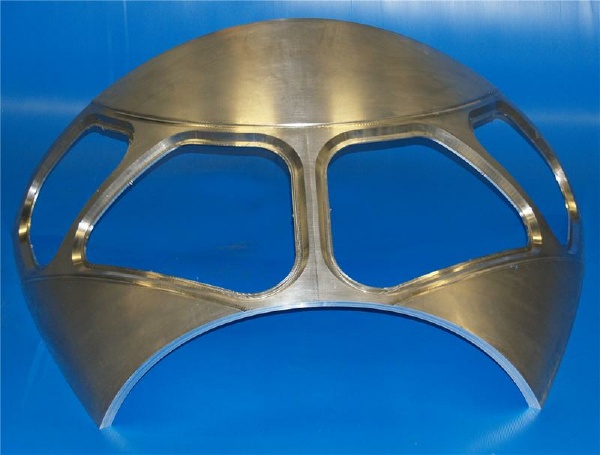3D-Metal Forming of Holland can manufacture complex aircraft components, like a cockpit fuselage, but recently demonstrated their explosive forming technology in a successful R&D-project for Airbus. The technology was developed to manufacture components for fusion reactors.
3D-Metal Forming presses metal plates up to 6 cm thick using shockwaves, without the material becoming weak and incurring hairline fractures. "We place the metal plates on top of a mold in a tank of water", explains 3D-Metal Forming director Hugo Groeneveld. "Next we precisely detonate explosives and the resulting shockwaves in the water then press the metal plate into every desired form. Using this technology we can make amazingly complex metal shapes."

Prototype part of an Airbus fuselage, created by explosive forming. Credit: 3D-Metal Forming BV
In 2005, 3D-Metal Forming could only process metal plates up to 15 mm thick. Hugo Groeneveld: "We were then asked if we could scale this up by a factor of four. That would namely be interesting for the construction of the large new experiment for fusion energy, ITER in South France." The company investigated this and developed a large-scale application of its technology. This work was supported by ITER-NL, a collaboration of Dutch knowledge institutes formed to involve Dutch companies in the construction of the fusion reactor ITER.
The construction of large science projects like ITER provides interesting opportunities for innovation and contains numerous contracts for specialised companies such as 3D-Metal Forming. A fusion reactor has the shape of an empty inner tube and the vacuum vessel, in particular, has many curved components that are difficult to produce using a punch or a press. Industrial Liaison Officer Toon Verhoeven from ITER-NL: "3D-Metal Forming possesses a unique technology with which it can actively participate in ITER. The quality of their work is evident from the fact that Airbus is now considering having them produce components for its aircraft fuselages."